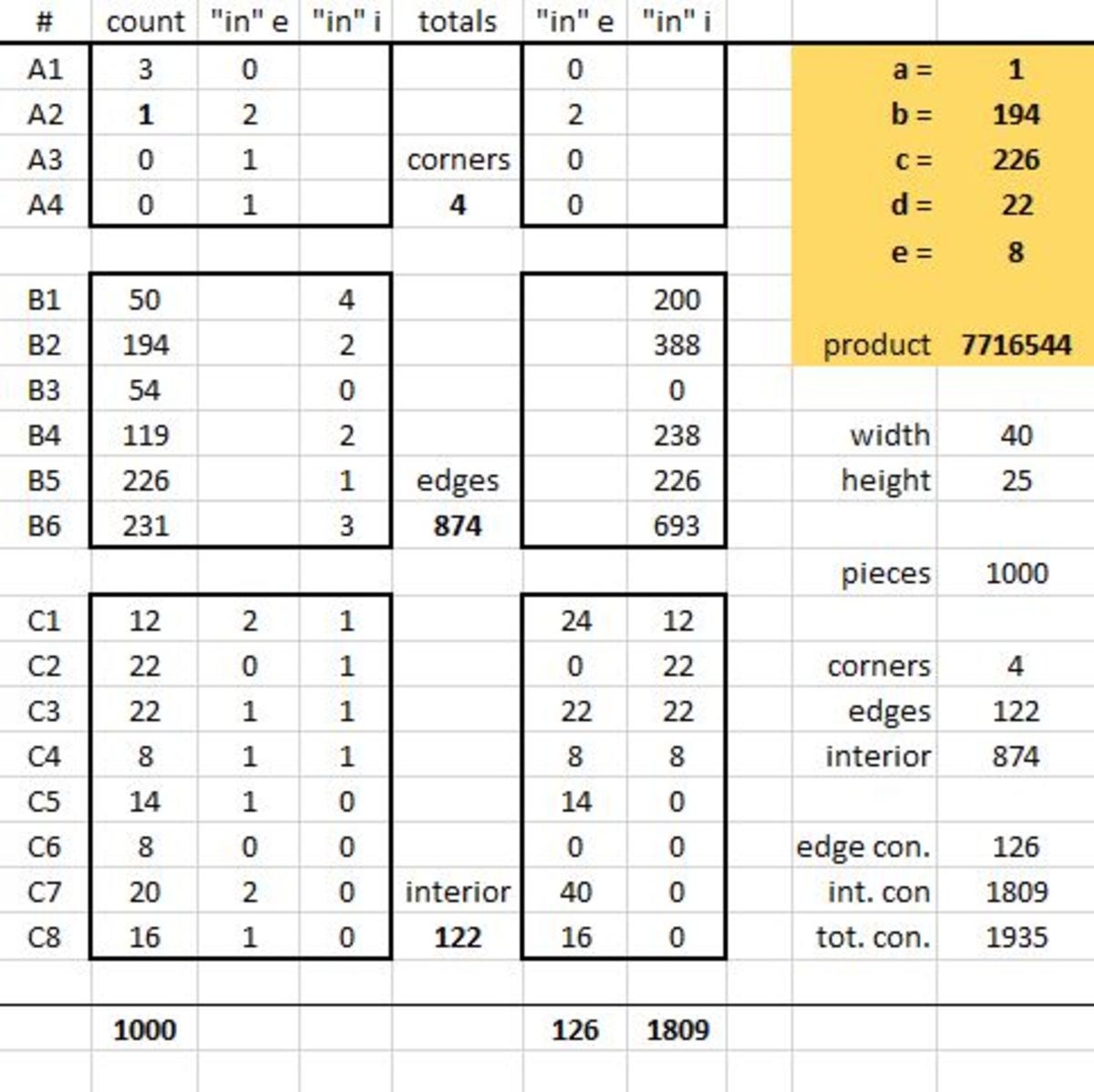Jigsaw Inventory
A jigsaw puzzle contains various kinds of pieces: corners, edges, and interior pieces. The diagram shows an inventory of the various shapes in a certain 40x25 jigsaw puzzle; in other words, the numbers on each piece is the number of those types of pieces in this puzzle. Shapes that are identical up to rotation have been grouped together.
Determine the five missing values. As your answer, submit the product .
The answer is 7716544.
This section requires Javascript.
You are seeing this because something didn't load right. We suggest you, (a) try
refreshing the page, (b) enabling javascript if it is disabled on your browser and,
finally, (c)
loading the
non-javascript version of this page
. We're sorry about the hassle.
The puzzle has 4 0 ⋅ 2 5 = 1 0 0 0 pieces, of which
4 corner pieces,
2 ⋅ ( 3 8 + 2 3 ) = 1 2 2 edge pieces, and
3 8 ⋅ 2 3 = 8 7 4 interior pieces.
Combining this with the information in each row in the diagram, we have ⎩ ⎪ ⎨ ⎪ ⎧ 3 + a = 4 4 5 4 + b + c = 8 7 4 9 2 + d + e = 1 2 2 ∴ a = 1 ∴ b + c = 4 2 0 ∴ d + e = 3 0
Let's work on the edges first ( d and e ). There are 2 ⋅ ( 2 4 + 3 9 ) = 1 2 6 edge/edge and edge/corner connections, and each of these connections has an "in" and an "out". We will therefore count the "in" connectors in the corner pieces and along the side of the edge pieces. 1 2 6 = # edge "in" = 2 + 2 ⋅ 1 2 + d + 8 + 1 4 + 2 ⋅ 2 0 + 1 6 = 1 0 4 + d . It follows that d = 1 2 6 − 1 0 4 = 2 2 and e = 3 0 − d = 8 .
Now we apply the same method for the remaining 2 3 ⋅ 3 9 + 2 4 ⋅ 3 8 = 1 8 0 9 connections. This time we count the "in" connectors of the interior pieces, as well as the "in" connectors of the edge pieces opposite the edge. 1 8 0 9 = # interior "in" = ( 1 2 + 2 2 + 2 2 + 8 ) + ( 4 ⋅ 5 0 + 2 ⋅ b + 2 ⋅ 1 1 9 + c + 3 ⋅ 2 3 1 ) 1 8 0 9 = 1 1 9 5 + 2 b + c ∴ 2 b + c = 6 1 4 . We already knew that b + c = 4 2 0 , so a simple subtraction shows that b = 6 1 4 − 4 2 0 = 1 9 4 and c = 4 2 0 − 1 9 4 = 2 2 6 .
The answer is therefore 1 ⋅ 1 9 4 ⋅ 2 2 6 ⋅ 2 2 ⋅ 8 = 7 7 1 6 5 4 4 .
And here is a little spreadsheet I used to check if the numbers work out: